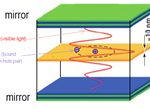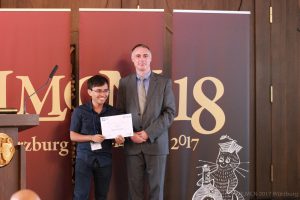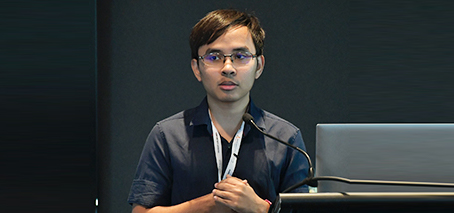FLEET collaboration traps light–matter particles

Exciton polariton: a composite particle composed of a photon (light) and an exciton (itself another composite particle: a bound electron-hole pair)
FLEET’s Research theme 2 seeks to create near-zero resistance flow of exciton polaritons, which are hybrid quasi-particles that are part matter and part light.
Their ability to flow without resistance relies on formation of an exciton-polariton condensate – a collective quantum state that behaves as a superfluid.
In superfluids, particles flow without encountering any resistance to their motion.
An exciton-polariton condensate is typically created within a semiconductor structure known as an optical microcavity, which enables strong coupling between the photons (light) and excitons (matter).
These microcavities are micrometre-scale heterostructures with two highly-reflective mirrors on either side of an optical medium.
This research took an important step forward in 2017 when FLEET researchers developed sufficiently high-quality microcavities to achieve a strong light–matter coupling regime and to ultimately achieve exciton-polariton condensation at room temperatures.
FLEET’s Monash University engineering labs developed the high-quality optical microcavities, which were designed by FLEET researchers at the ANU, led by FLEET PhD student Eliezer Estrecho.
Following fabrication the structures were characterised in the exciton-polariton laboratory at ANU to assess their suitability for embedding the necessary exciton-hosting medium (an atomically-thin semiconductor monolayer) and creating exciton polaritons.

Microcavities: micrometre-scale structures comprising an optical medium sandwiched between ultra-reflective mirrors, used to confine light such that it forms exciton polaritons
The main achievement of the experiment was the extended lifetime of the photon trapped in the microcavity, which was at least an order of magnitude larger than that achieved previously in microcavities of similar design. This vastly improves the chances of reaching the strong light-matter coupling regime necessary for observing exciton–polaritons in these structures.
The ability to develop and characterise optical microcavities ‘in-house’ at FLEET is extremely important for future Centre research as it enables fabrication of highly customised semiconductor devices precisely tailored for studies of exciton-polariton condensation and superfluidity.
The knowledge gained in design, fabrication and optical characterisation of the new microcavities will now be applied in creation of an optimised host structure for exciton polaritons in atomically-thin semiconductor monolayers.
Design, theory, and characterisation was done at the ANU in collaboration with RIKEN (Japan), while nanofabrication was performed by FLEET researchers at Monash University. Eliezer Estrecho’s two-months training with Centre partners at Würzburg University allowed him to take the lead of this project at the ANU.

PhD student Eliezer Estrecho awarded 1st Poster for ‘Single-shot imaging of exciton-polariton condensates’ at PLMCN18–international conference on physics of light-coupling in nanostructures. Pictured with PI Sven Höfling at University of Würzburg.
Collaborating FLEET personnel:
• Eliezer Estrecho, ANU
• Elena Ostrovskaya, ANU
• Qiaoliang Bao, Monash University
• Tinghe Yun, Monash University
FLEET’s Research theme 2: exciton superfluids
FLEET pursues three research themes to develop systems in which electrical current can flow with near-zero resistance, in the search for ultra-low energy electronics.
FLEET’s second research theme uses a quantum state known as a superfluid to achieve electrical current flow with minimal wasted dissipation of energy.
In a superfluid, scattering is prohibited by quantum statistics, which means that charge carriers can flow without resistance.
A superfluid is a quantum state in which all particles flow with the same momentum, and no energy is lost to other motion. Particles and quasi-particles, including both excitons and exciton polaritons, can form a superfluid.
Theme 2 researchers are seeking to create superfluid flows following three approaches:
- Exciton-polariton bosonic condensation in atomically-thin materials
- Topologically-protected exciton-polariton flow
- Exciton superfluids in twin-layer materials
If exciton-superfluid devices are to be a viable, low-energy alternative to conventional electronic devices, they must be able to operate at room temperature, without energy-intensive cooling. Thus, FLEET seeks to achieve superfluid flow at room temperature, which can be achieved using atomically-thin semiconductors as the medium for the superfluid.
For more information:
- Prof Elena Ostrovskaya Research theme 2 leader, Chief Investigator elena.ostrovskaya@anu.edu.au
- FLEET Research theme 2 news
- Errol Hunt FLEET communications coordinator media@FLEET.org.au
- Polariton BEC Research Group at ANU polaritonbec.org
- @FLEETCentre
Quote
““Exciton–polariton research is entering its most active and exciting phase around the world” Prof Elena Ostrovskaya

